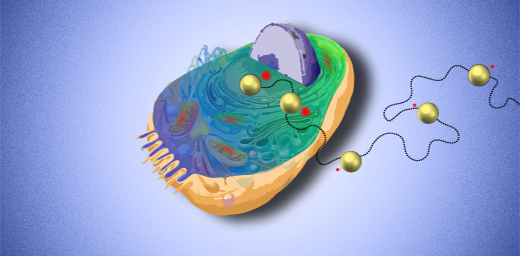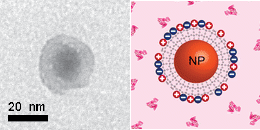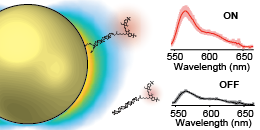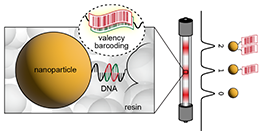

Physical Materials and Materials Biology
Inorganic nanomaterials are of a similar dimension to biological macromolecules and assemblies, and often have unique size-, shape- and material-dependent properties. As a result, these nanomaterials hold great promise for biomedical sciences, with applications as potential therapeutics or sensors which can probe the heterogeneous and complex environment of the cellular interior. Our lab is uniquely positioned to study nanoparticle-biomolecule and nanoparticle-cell interations from the single-molecule and single-particle level. This research also extends to investigating how to controllably interface nanomaterials with biological matter and the development and characterization of new functional photoluminescent and plasmonic nano-probes for use in biological settings.

Nanoprobes Development
Inorganic nanoparticles and nanostructures are advantageous as chemical and biological probes by virtue of their size-dependent optical properties. We are applying single-molecule and single-particle techniques to understand the fundamentals of their behavior along with exploring various applications.
Links: ACS Nano, 5, 5067-5071 (2011): first nanoparticle temperature sensing in live cells; ACS Nano, 5, 9511-9522 (2011): ratiometric temperature sensing; J. Am. Chem. Soc., 137, 580-583 (2015): coating to resist hard protein corona.
Plasmonic Antennas and Resonators
Plasmonic nanoparticles modify their nanoscale environment by converting incident light into intense local electromagentic fields or heat. While the intense local field can modulate the photophysics of nearby molecules and lead to fluorescence enhancement, the generation of nanoscale thermal gradients has interesting implications for particle motion and photothermal therapy. We are using quantitative bulk and single-particle spectroscopy to study these phenomena, both experimentally and theoretically, as well as developing methods to reproducibly synthesize complex functional plasmonic nanostructures and interface them with biological materials for use as optical antennas or actuators in the cellular space.
Links: Anal. Chem., 93, 8045-8053 (2021): accurate plasmon enhancement in bulk solution.
Valency-Defined Nano-Synthons
Thinking of nanoparticles tagged with a defined number of DNA molecules as ‘nano-synthons’ continues to inspire new pathways for developing novel materials and nanotechnologies. Yet, practical limitations have prevented the community from effectively translating this powerful idea to real-world applications: available nano-synthons are confined to small nanoparticles (typically sizes < 40 nm), and they can only be produced in analytical amounts (sufficient only for single-particle proof-of-principle demonstrations). We have put forward a new concept capitalizing on the digital nature of DNA hybridization to enable reagent-scale purification of valency-defined nanoparticles of various sizes, shapes, and materials.
Links: J. Am. Chem. Soc., 144, 12915-12923 (2022): first conceptualization and realization.Updated: 2024.02.23.














